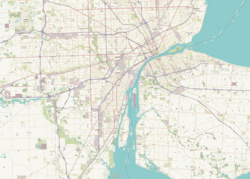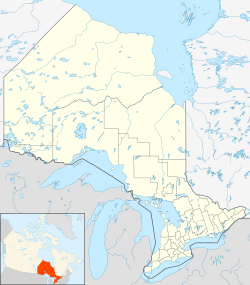Peche Island facts for kids
| Geography | |
|---|---|
| Location | Detroit River |
| Coordinates | 42°20′45″N 82°55′31″W / 42.34583°N 82.92528°W |
| Area | 86 acres (35 ha) |
| Highest elevation | 574 ft (175 m) |
| Administration | |
|
Canada
|
|
| Province | Ontario |
| County | Essex |
| City | Windsor |
| Demographics | |
| Population | 0 (permanent) |
Peche Island is a beautiful, uninhabited island in the Detroit River. It's owned by Canada and is a special spot for nature and fun. The island is about 86 acres (35 hectares) big. It sits right where the Detroit River flows into Lake St. Clair.
Peche Island is located about 1.2 miles (1.9 km) east of Belle Isle. It's also very close to the shore of Windsor, only 360 yards (330 m) away.
This island was once part of the Canadian shoreline. Over time, the Detroit River's currents shaped it into an island. It has a marsh in the middle and man-made channels. These channels help keep fresh water flowing and offer places for recreation. The plants and animals on the island have changed a lot because of human activity. Today, the forest you see is part of a special effort to restore the island.
Peche Island used to be an Ontario provincial park. But in 1999, ownership was given to the City of Windsor. Large ships, up to 1,000 feet (300 m) long, pass by the island daily.
Contents
Fun Things to Do on Peche Island
The island offers amazing views of Detroit city. It has a wide, sandy beach and shallow water, making it a favorite spot for boaters in the summer.
How to Visit Peche Island
Since June 27, 2018, the City of Windsor has offered a ferry service to the island. This ferry runs on Wednesdays, Saturdays, and Sundays from June to October, if the weather is good. If you have your own boat, canoe, or kayak, you can also visit.
Exploring the Island's Trails
Visitors can enjoy the island's trails and beaches. There are also about 2.5 miles (4 km) of canals to explore. Remember, the park is only open during the day.
Boating Tips for Peche Island
Sailors should anchor their boats along the southern shore of the island. This is near the Windsor Yacht Club. When you are between the red buoy DP2 (west of Peche Island) and the green buoy DP5 (east of Peche Island), you must go slower than 5 knots (9 km/h). If you're kayaking, paddling around the whole island is about 3 miles (4.8 km).
Wildlife and Nature on Peche Island
Peche Island is a great place to see many different kinds of wildlife, especially birds and fish.
Birds of Peche Island
From November to March, many waterfowl gather in the waters near the island. These include canvasbacks, redheads, lesser scaups, common goldeneyes, and common mergansers. Sometimes, you can even spot Peregrine falcons and bald eagles. They are often attracted by the large groups of ducks and might be seen perched in tall trees or on special nesting platforms built by local nature groups.
Fish and Trees Around Peche Island
The waters around Peche Island are home to many fish. You can find muskie, walleye, bigmouth bass, bluegill, and perch. Fishing here is not very common, so there are usually plenty of fish. The water quality is also very good and is checked often, as the City of Windsor gets its water supply from nearby. Peche Island is also one of the few places where you can find the rare blue ash tree (Fraxinus quadrangulata).
The Name of Peche Island
The island's name has an interesting history, going back to early French explorers.
Early Names of the Island
On old maps made by early French explorers, the island was called "Isle au Large" or "Isle du Large." This might mean "at a distance," because Peche Island is the farthest island upstream on the Detroit River before you reach Lake St. Clair. It could also mean "keep your distance," because of dangerous shallow areas on the north side.
"Peche" and its Meaning
Later, the island's name changed to variations of "Peche" Isle, like "Isle aux Pecheurs" or "Isle a la Peche." In French, "peche" means "fishing." This makes sense because the island was once used as a fishing station. Some local stories incorrectly say the name comes from a peach orchard that was once there. Others link the name to the French word for "sin," claiming the island was a place for duels or secret meetings.
Peche Island's History
Peche Island has a rich history, from Native American use to famous owners and big development plans.
Early Inhabitants and Ownership
For many years, Native Americans, including the Ottawa Native Chief Pontiac, used the island in the summer. It was known as a Native fishing village because of the many white fish in the surrounding waters. After Europeans arrived, Alexis Maisonville bought the island from the Ottawa Natives in 1774. However, this purchase was later cancelled by Governor Dorchester, and all islands became Native lands again.
The first known permanent residents were a French-Canadian family called LaForest. They lived on the island and shared it with local Natives. The LaForest family did not have a formal deed to the island, but they were allowed to fish there. Even when the island's ownership was transferred to the Crown by the Chippewa Indians in 1857, the LaForest family was not asked to leave. Records from 1859 show three log homes on the island, belonging to members of the LaForest family.
The Walker Era
In 1868, members of the LaForest family sold the island for $300 to William Gasper Hall. They then moved to farm land across from the island. A story or legend says that the LaForest family felt they were forced to sell and put a "curse" on Peche Island as they left.
In 1883, Hiram Walker's sons bought the island. Hiram Walker, a famous distiller, used it as his summer home. He tried for many years to develop the island. He had canals dug to bring in supplies and keep fresh water flowing. He also bought yachts, the Pastime and the Lurline, for travel to the island and for parties.
Walker built a large 40-room mansion on the island. He planted many trees and created an orchard. He also built a greenhouse for flowers, a golf course, stables, an icehouse, and a carriage house. A generator was built to provide electricity. Today, the only thing left of the Walker estate is the ruins of the mansion, which was destroyed by a fire in 1929.
Amusement Park Dreams and Later Plans
In 1907, the Detroit, Belle Isle, & Windsor Ferry Company, which owned Boblo Island Park, bought Peche Island. In 1913, they announced plans to turn it into an amusement park. The company's president even lived in Walker's summer home while planning the new resort.
The island was sold again in 1956 and then in 1962 to E. J. Harris. He had a big vision for a $30 million resort. His plan included expanding the island, building an 18-hole golf course, and creating Canadian-themed recreation areas like ice skating and a ski hill. He even planned for a hotel and a cable car service from Windsor and Detroit. On the island, transport would be by horse and carriage or dog sleds. Some of this work was started, and buildings were constructed. However, due to problems, Harris faced strong opposition and eventually lost a lot of money. He put Peche Island up for auction.
The island was briefly owned by another developer who wanted to build an exclusive residential community. But in 1974, the Government of Ontario bought it back for $400,000. They planned to make it a nature area with trails and mooring spots, but these plans didn't fully happen due to lack of money. It was named a provincial park but never fully operated as one.
Peche Island Today
On January 1, 1999, the City of Windsor bought Peche Island from the Province of Ontario for about $1.3 million. The city also received water lots and land on the mainland. The City of Windsor does not plan to develop the island further, beyond keeping public toilets available.
In 2018, the City of Windsor announced it would spend $1 million on a pontoon boat. This boat would allow residents without their own boats to visit the island. The boat can carry about a dozen people or cyclists and operates only in the summer.
Shipwrecks Near Peche Island
The waters around Peche Island have seen a few shipwrecks over the years.
- In 1865, the schooner Eugenie (a type of sailing ship) wrecked on Peche Island.
- The steamship Oneida ran aground there in July 1871.
- More recently, on July 8, 1998, the Tadoussac ran aground about 2 miles (3.2 km) east of Peche Island.
The Peche Island Lighthouse
A lighthouse once stood near Peche Island, helping ships navigate the waters.
Building the Lighthouse
The Peche Island Rear Range Light was built in 1908. It was made of cast iron and helped mark the narrow passage from Lake St. Clair into the Detroit River. This lighthouse was never staffed by a person.
The Lighthouse's Journey
In 1926, the lighthouse was made taller, reaching 66 feet (20 m). It continued to guide ships for about 75 years. However, on September 23, 1983, it was set to be taken down and destroyed. When people in Marine City, Michigan heard about this, they started an effort to save it. They wanted to move it to their city's Waterworks Park. The lighthouse was very heavy, weighing 35 tons, and was 66 feet (20 m) tall with a diameter of 14 feet (4.3 m). Moving it required a lot of clever planning and hard work, but they successfully moved it to its new home.
Images for kids






